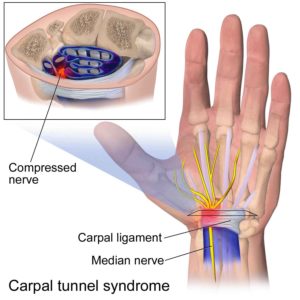Blog
Carpal Tunnel Syndrome – Pain in the Wrist and Hand

Carpal tunnel syndrome is a condition caused by entrapment of the median nerve, resulting in pain, numbness and pins and needles in the fingers and hand.
Anatomy of the Wrist
The carpal tunnel is an important passageway of the wrist containing the nine flexor tendons of the fingers and hand, as well as the median nerve.
The tunnel is formed by the transverse carpal ligament that attaches to carpal bones of the wrist. This ligament is a strong, broad connective tissue structure that is quite rigid and has little capacity to stretch.
The median nerve provides sensation to the thumb, index, middle and ring fingers, as well as controlling muscles around the base of the thumb.
What is Carpal Tunnel Syndrome?
Carpal tunnel syndrome presents through a variety of neurological symptoms and pain in the hand and wrist, normally with a slow onset of symptoms. Night time symptoms are largely prevalent.
Symptoms include:
- Neurological signs in the thumb, index and middle/ring fingers including numbness, tingling, burning
- Sharp shock-like sensations radiating into the thumb and digits
- Pain or tingling that travels up the forearm toward the shoulder (uncommon)
- Weakness and clumsiness in the hand: increased difficulty in everyday tasks like using a key to unlock a door or doing up buttons
- Dropping things due to lost sensation
Diagnosis of CTS occurs via some simple tests that your physiotherapist will perform, as well as reported neural symptoms. A common comment that patient’s will make is that they find they are able to ease their symptoms by shaking their hand (flick sign).
Managing Carpal Tunnel Syndrome
Best management is always conservative first, as there are large healing times and more potential for complications with surgery.
Management strategies include but are not limited to:
- Bracing/splinting – normally for night time to prevent the wrist getting into any awkward or provoking positions.
- Activity modifications – as symptoms are generally caused by maintaining the same position for prolonged periods, coming up with strategies to avoid this is a large part of improving the patient’s quality of life.
- Nerve gliding exercises – these help to desensitise and improve the movement of the median nerve to reduce the irritation.
If you know someone or are someone who is suffering with similar symptoms to the described above, please contact us on 1800 992 999 or [email protected] to book an appointment today! Let us help you live a pain free life!
For more information visit:
https://orthoinfo.aaos.org/en/diseases–conditions/carpal-tunnel-syndrome/
